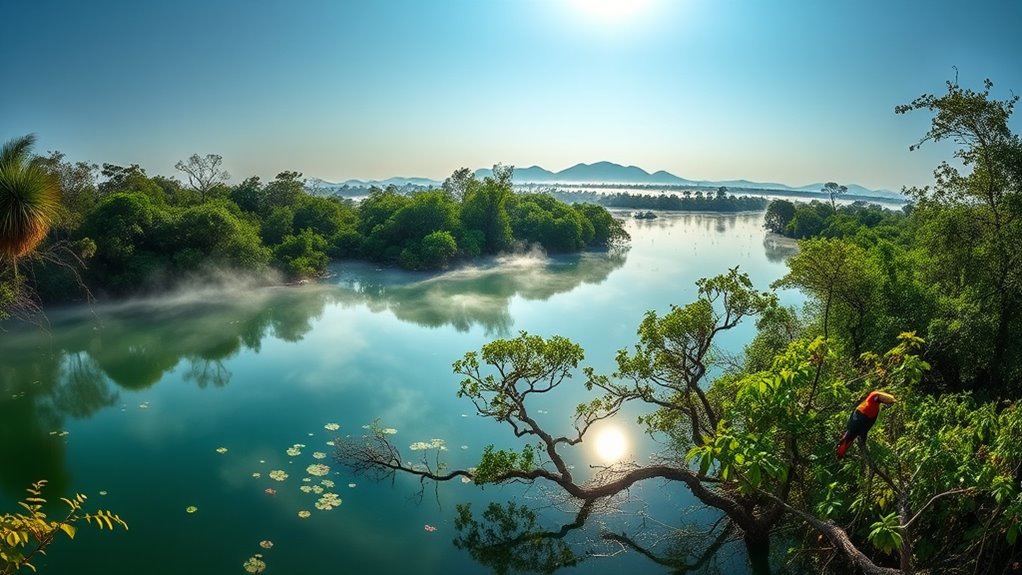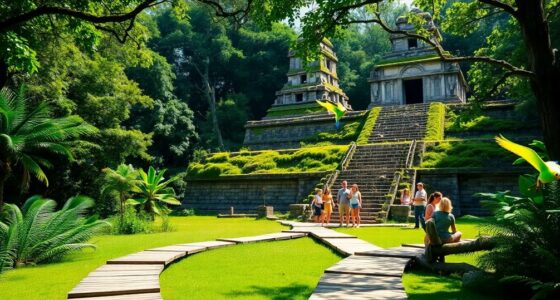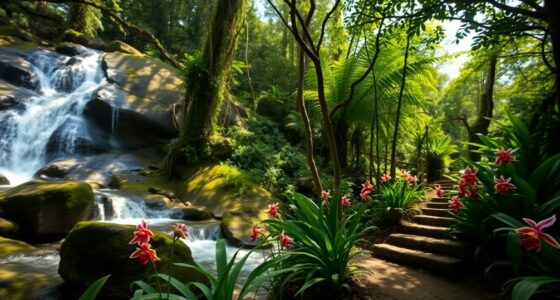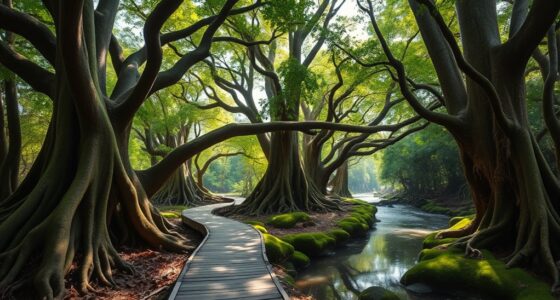The protected wetlands of the Pantanal in Brazil are essential for conserving diverse wildlife, including iconic species like jaguars, hyacinth macaws, and giant otters. These areas cover rivers, lakes, and floodplains that fluctuate with seasonal rains, supporting rich ecosystems. Conservation efforts focus on habitat restoration, controlling invasive species, and sustainable practices like eco-tourism. To learn how ongoing projects balance preservation with local livelihoods, keep exploring the fascinating strategies behind the Pantanal’s ecological resilience.
Key Takeaways
- The Pantanal is one of the world’s largest and most vital wetland ecosystems, supporting rich biodiversity and migratory bird populations.
- It includes protected areas and reserves focused on wetland restoration and habitat conservation.
- Conservation efforts involve controlling invasive species like water hyacinth and restoring water flow.
- Community involvement through eco-tourism and sustainable practices plays a crucial role in preservation.
- Challenges include habitat loss from agriculture, infrastructure, and climate change, requiring integrated management strategies.
The Geographical Scope of the Pantanal’s Protected Areas
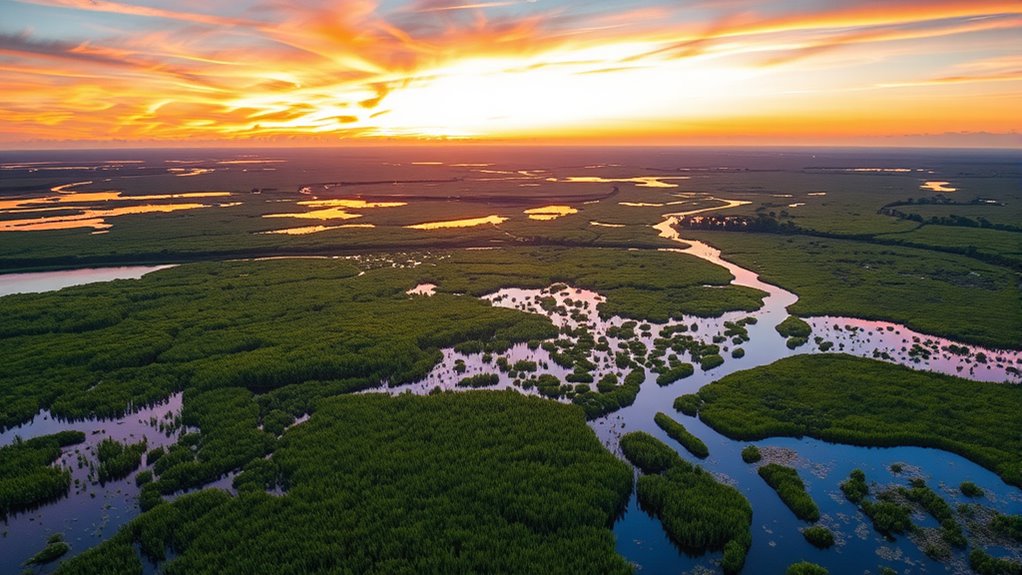
The protected areas within the Pantanal cover a vast and diverse geographical region that spans parts of Brazil, Bolivia, and Paraguay. These zones are essential for wetland restoration, helping to recover degraded habitats and guarantee ecological balance. Managing invasive species is a key part of this effort, as non-native plants and animals threaten native biodiversity. By focusing on invasive species management, conservationists protect the natural processes that sustain this unique landscape. You’ll find that these protected zones vary in size and ecosystem type, but each plays a crucial role in maintaining water quality, supporting wildlife, and safeguarding the region’s ecological integrity. As you explore, you’ll see how coordinated efforts across borders help preserve the Pantanal’s rich and fragile environment.
Key Ecosystems Within the Pantanal Wetlands
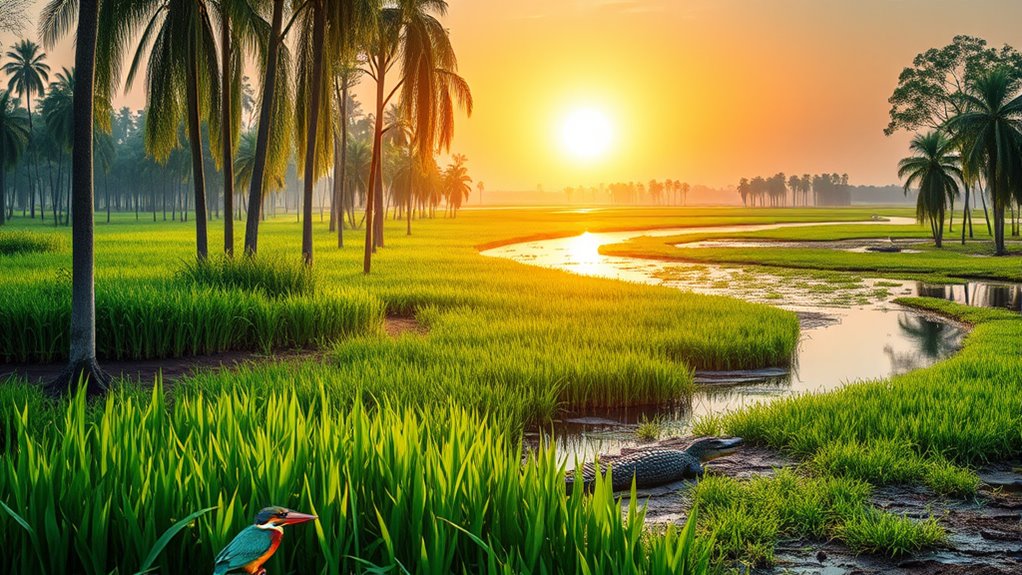
You’ll find that the Pantanal hosts a variety of aquatic habitats, each supporting unique plant and animal life. These ecosystems create an ideal environment for the region’s renowned bird populations. Understanding these key ecosystems helps highlight the importance of preserving the wetlands’ rich biodiversity. Additionally, the diverse habitats contribute to the region’s endless fun for nature enthusiasts and researchers alike.
Diverse Aquatic Habitats
Diverse aquatic habitats form the core of the Pantanal’s ecological richness, supporting a wide array of plant and animal species. These habitats include rivers, lakes, floodplains, and channels that fluctuate with seasonal rains. Your efforts in wetland restoration help preserve these essential ecosystems, ensuring their resilience. Be aware that invasive species threaten native biodiversity and can disrupt habitat balance. To maintain habitat health, control invasive plants and fish that compete with native species. Promoting biodiversity conservation within these habitats is essential for sustaining their ecological functions and resilience.
Rich Bird Populations
Bird populations thrive across the Pantanal’s wetlands, making it one of the most essential ecosystems in the region. These wetlands support a diverse array of species during bird migration and breeding seasons. Wetland restoration efforts have helped preserve critical habitats, ensuring birds have ample nesting sites and feeding grounds. The area attracts countless migratory birds from North and Central America, creating vibrant seasonal flocks. This abundance highlights the importance of maintaining protected zones. Protecting these habitats is crucial for bird conservation and overall ecosystem health.
Iconic Species of the Pantanal’s Conservation Zones
You’ll find some of the Pantanal’s most remarkable species here, each playing a crucial role in the ecosystem. Jaguars stand as fierce top predators, while the vibrant hyacinth macaws add striking color to the skies. Don’t forget the giant otters, who rule the waterways as playful aquatic champions. Supporting ethical wildlife conservation efforts helps preserve these incredible species for future generations.
Jaguar: The Top Predator
As the apex predator of the Pantanal’s wetlands, jaguars play a crucial role in maintaining the region’s ecological balance. They control prey populations, ensuring healthy prey and predator relationships. Your efforts in wetland restoration support jaguars by preserving their habitat and reducing threats from invasive species that can disrupt food chains. Protecting these top predators helps maintain biodiversity and ecological integrity. Additionally, sustainable management practices aligned with environmental sustainability principles can enhance conservation outcomes for jaguars and their habitat.
Hyacinth Macaw: Vibrant Feathered Icon
The Hyacinth Macaw, with its striking cobalt blue feathers and powerful beak, stands out as one of the most iconic species in the Pantanal’s conservation zones. As a Feathered Icon, it symbolizes the vibrant biodiversity of this region. You’ll notice these large parrots soaring gracefully through the skies or gathering in pairs near water sources. Their intelligent behavior and strong bonds make them a favorite among wildlife enthusiasts. The Hyacinth Macaw’s bright plumage not only captures your attention but also highlights the importance of protecting their habitat. Conservation efforts focus on preserving the native palm trees they rely on for food and nesting. Seeing this Feathered Icon thriving in the wild reminds you of the essential role the Pantanal plays in sustaining such extraordinary species. Additionally, understanding the significance of native flora in their environment emphasizes the need for ongoing habitat preservation.
Giant Otters: Aquatic Champions
Did you know that giant otters are among the most charismatic and vital residents of the Pantanal’s waterways? Their presence signals healthy wetlands and highlights the importance of wetland restoration efforts. These aquatic champions rely on clean, unspoiled habitats to thrive, making conservation essential. You can support efforts to control invasive species that threaten their environment and food sources.
- Maintain natural water flow and vegetation to promote wetland restoration
- Monitor and remove invasive species disrupting native ecosystems
- Protect key habitats to guarantee sustainable populations of giant otters
- Promoting ecosystem health is critical for the survival of these iconic species.
Major Protected Areas and Their Unique Features

Among the protected areas in the Pantanal, the Nhecolândia sub-region stands out for its extensive wetlands that support a rich diversity of wildlife. Here, vast flooded plains and seasonal pools create a dynamic landscape crucial for many species. You’ll notice efforts in wetland restoration, which help maintain water quality and habitat stability, especially as invasive species threaten native flora and fauna. Imagine this scene:
| Wetlands Features | Wildlife & Conservation Focus |
|---|---|
| Vast, seasonal floodplains | Rich bird populations, including jabiru and herons |
| Shallow lakes and marshes | Efforts to control invasive plants like water hyacinth |
| Native grasslands and riparian zones | Protecting species like giant otters and capybaras |
| Restoration projects improving water flow | Combating invasive species to preserve biodiversity |
Conservation Strategies and Management Practices
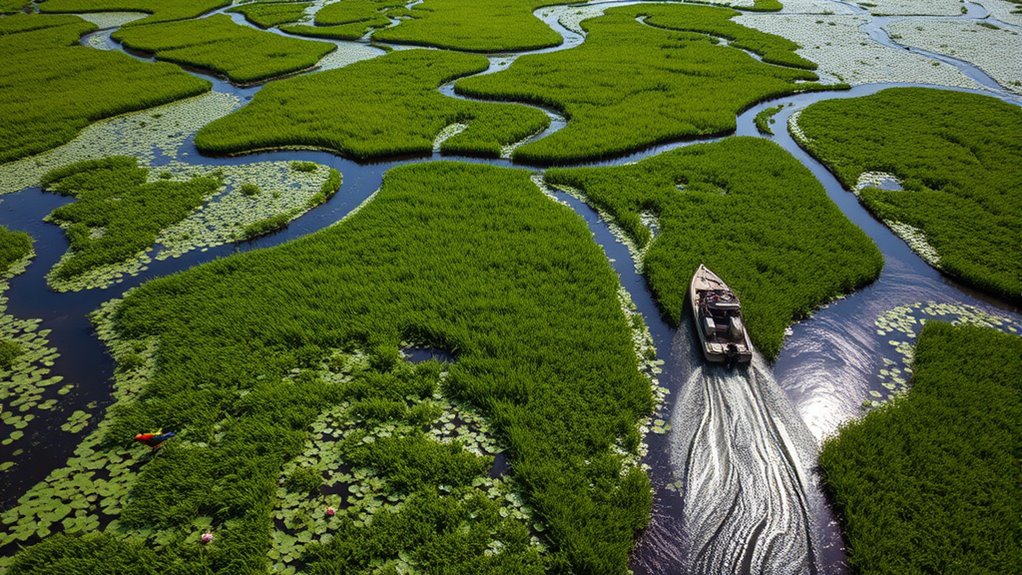
Effective conservation in the Pantanal relies on a combination of strategies that actively protect and restore its delicate ecosystems. Central to this is wetland restoration, which involves rehabilitating degraded areas to improve biodiversity and water quality. Policy implementation also plays a vital role, ensuring legal protections and sustainable land use. You can support these efforts by focusing on:
- Restoring natural hydrology through wetland restoration projects
- Enforcing policies that limit deforestation and illegal activities
- Promoting adaptive management practices based on scientific monitoring
- Incorporating Remote Hackathons to foster innovative solutions for conservation challenges
These practices help maintain ecological balance, prevent habitat loss, and enhance resilience against climate change. Combining restoration efforts with strong policy enforcement creates a sustainable framework for preserving the Pantanal’s unique wetlands for future generations.
The Role of Local Communities in Wetland Preservation
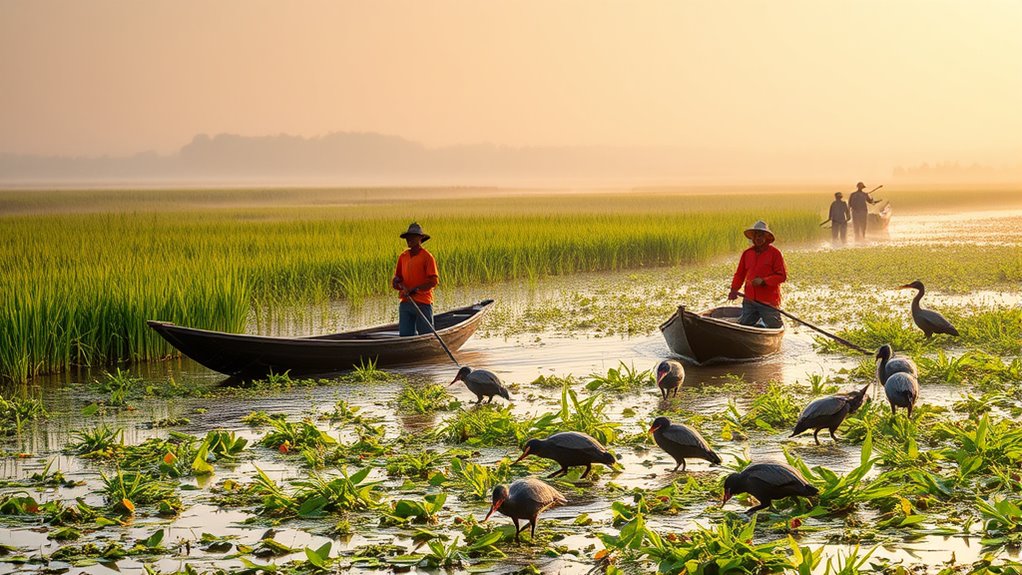
Local communities play a vital role in safeguarding the wetlands of the Pantanal by actively participating in conservation efforts and sustainable practices. Your community’s engagement helps preserve biodiversity and supports eco-friendly livelihoods. By embracing traditional practices, you maintain cultural heritage while promoting conservation. Such practices often include sustainable fishing, cattle grazing, and harvesting native plants responsibly. Your involvement ensures that conservation isn’t just top-down but rooted in local knowledge. To illustrate, here’s how different community efforts contribute:
| Initiative | Impact | Traditional Practice |
|---|---|---|
| Eco-tourism | Raises awareness | Community-led tours |
| Sustainable fishing | Maintains fish populations | Selective netting |
| Land management | Preserves habitats | Rotational grazing |
| Education programs | Empowers future generations | Cultural storytelling |
Engaging with conservation strategies enhances the effectiveness of these initiatives. Your active participation sustains the Pantanal’s delicate balance.
Challenges Facing the Pantanal’s Wetlands

You need to recognize the major threats facing the Pantanal’s wetlands, like deforestation and changing land use. These activities threaten the delicate balance of the ecosystem and put native species at risk. Additionally, climate change intensifies droughts and floods, further stressing this essential habitat. Implementing effective conservation strategies is crucial to protect this unique environment for future generations.
Deforestation and Land Use
Despite its status as a protected area, the Pantanal faces ongoing threats from deforestation and land use changes driven by agriculture, cattle ranching, and infrastructure development. These activities lead to habitat loss, disrupting local ecosystems and threatening species. Agricultural expansion often encroaches on wetland areas, reducing habitat availability. Urban development pushes into previously untouched regions, fragmenting the landscape. Additionally, infrastructure projects like roads and dams further accelerate deforestation and alter water flow patterns. To understand these impacts, consider:
- Expansion of farmland and cattle grazing areas
- Construction of roads and urban settlements
- Water diversion for agriculture and development
These land use changes threaten the delicate balance of the Pantanal’s wetlands, risking long-term ecological health.
Climate Change Impacts
Climate change poses a significant threat to the Pantanal’s wetlands by altering weather patterns, increasing temperatures, and intensifying extreme weather events. These changes disrupt the delicate balance of the ecosystem, risking habitat loss and reduced biodiversity. To combat this, wetland restoration becomes essential, helping to rebuild natural buffers against floods and droughts. Strengthening climate resilience involves protecting existing wetlands and restoring degraded areas, ensuring they can absorb shocks from climate variability. By focusing on proactive measures, you can help preserve the Pantanal’s unique environment for future generations. Supporting conservation efforts and sustainable practices will enable the wetlands to adapt more effectively to climate change’s impacts, safeguarding this critical ecosystem from ongoing and future threats.
Ecotourism and Its Impact on Conservation Efforts
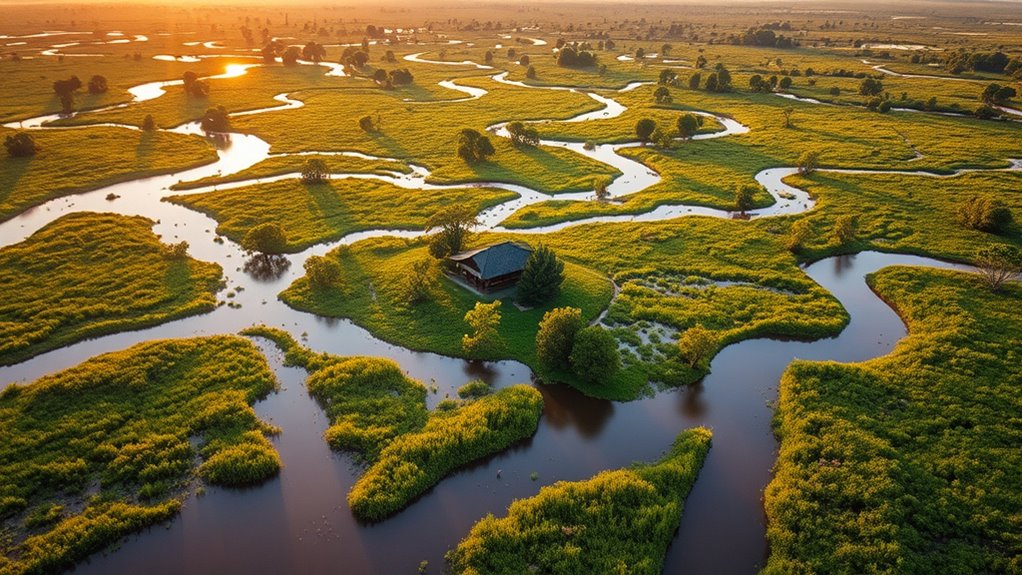
Ecotourism in the Pantanal has become a powerful tool for promoting conservation efforts, drawing visitors who are enthusiastic to experience its unique wetlands while supporting local communities. Your participation encourages eco lodge development, which provides sustainable employment and infrastructure. Birdwatching tourism attracts enthusiasts eager to spot exotic species, raising awareness about preserving habitats. By engaging in responsible tourism practices, you help minimize environmental impact and promote conservation funding. This influx of eco-conscious travelers fosters community involvement and supports local economies.
Ecotourism in the Pantanal supports conservation, local communities, and sustainable livelihoods through responsible travel and eco-lodge development.
- Eco lodge development boosts sustainable livelihoods
- Birdwatching tourism raises awareness for habitat preservation
- Responsible travel practices mitigate environmental impact
Scientific Research and Monitoring Initiatives
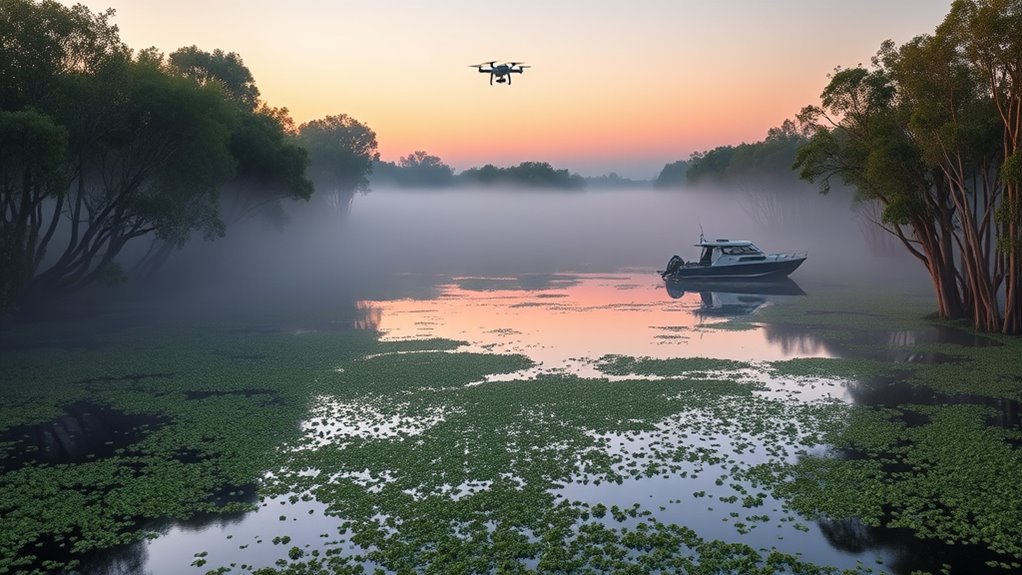
Have you ever wondered how scientists monitor the health of the Pantanal’s delicate ecosystems? They use a variety of scientific research and monitoring initiatives to track changes over time. These efforts include studying wetland restoration projects, which help repair degraded areas and support biodiversity. Researchers also focus on species migration patterns, observing how animals move across different habitats to ensure their populations thrive. By collecting data on water quality, vegetation, and wildlife, scientists can identify threats like pollution or habitat loss early on. This proactive approach allows for adaptive management, guaranteeing the wetlands remain resilient. Your understanding of these initiatives highlights their importance in maintaining the Pantanal’s ecological balance and safeguarding its unique biodiversity for future generations.
Future Perspectives for the Preservation of the Pantanal

Looking ahead, the preservation of the Pantanal depends on innovative strategies and strengthened policies that balance ecological health with human activities. Wetland restoration efforts will be vital to recover degraded areas and maintain biodiversity. Controlling invasive species is essential to prevent them from outcompeting native flora and fauna, which threatens ecosystem stability. You should support policies promoting sustainable land use, water management, and community involvement to guarantee long-term conservation.
- Invest in wetland restoration projects that restore natural hydrology
- Implement measures to control and eliminate invasive species
- Foster local community engagement and education for sustainable practices
Frequently Asked Questions
How Do Seasonal Floods Influence Wetland Biodiversity in the Pantanal?
You might wonder how seasonal floods affect biodiversity. Flood pulse dynamics drive these changes, causing seasonal habitat shifts that transform the landscape. During floods, wetlands expand, providing critical breeding and feeding grounds for countless species. As waters recede, habitats shift, supporting different plants and animals. This natural cycle sustains diverse ecosystems, ensuring species thrive year-round. Your understanding of these processes highlights the importance of preserving such dynamic and essential wetland environments.
What Are the Traditional Uses of Wetlands by Indigenous Communities?
Did you know that many indigenous communities rely on wetlands for over 70% of their daily resources? You might participate in traditional harvesting, gathering plants, fish, and medicinal herbs, which sustains your community. Wetlands also serve as sacred spaces for cultural rituals, strengthening your spiritual connection to the land. These practices preserve your heritage, support your livelihood, and maintain ecological balance, showing how essential wetlands are to your cultural identity.
How Does Climate Change Threaten the Pantanal’S Wetland Ecosystems?
You see, climate change threatens wetlands by disrupting water cycles, causing unpredictable floods and droughts. This challenges ecological resilience, making ecosystems more vulnerable. To adapt, you need climate adaptation strategies like restoring natural water flows and protecting native vegetation. These efforts help wetlands recover and maintain their essential functions, ensuring they continue supporting diverse species and local communities despite changing climate conditions.
What Specific Policies Protect the Wetlands From Industrial Development?
You should focus on wetland conservation policies that aim to limit industrial development in sensitive areas. These policies often include strict regulations, protected status designations, and enforcement measures to prevent harmful activities. By supporting and advocating for strong policy enforcement, you help guarantee the wetlands are preserved for future generations. Effective policies serve as crucial tools to balance economic growth with environmental protection, safeguarding these essential ecosystems from industrial threats.
How Do Invasive Species Impact Native Flora and Fauna in the Pantanal?
Invasive species threaten native flora and fauna by outcompeting them for resources, disrupting ecosystems, and altering habitats. You might notice invasive plants spreading rapidly, crowding out native species, or invasive animals preying on or competing with native wildlife. These invasive species create intense native competition, reducing biodiversity and impacting the health of ecosystems. Managing these threats requires early detection and control efforts to preserve the natural balance and protect native species’ survival.
Conclusion
As you explore the protected wetlands of the Pantanal, imagine it as a vibrant, living mosaic where every piece—flora, fauna, and conservation effort—interlocks to sustain its breathtaking beauty. Your role in supporting sustainable practices and research becomes the brushstrokes that preserve this jewel’s shimmering waters and teeming life. Together, you can guarantee this lush sanctuary remains a radiant, thriving symphony for generations to come, a true demonstration of nature’s resilience.

